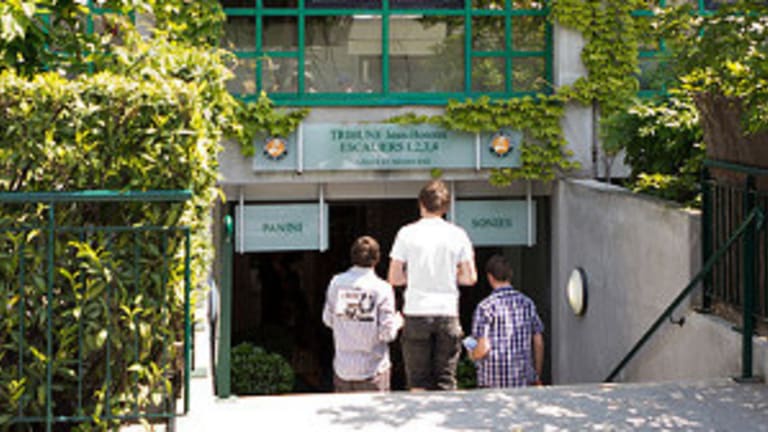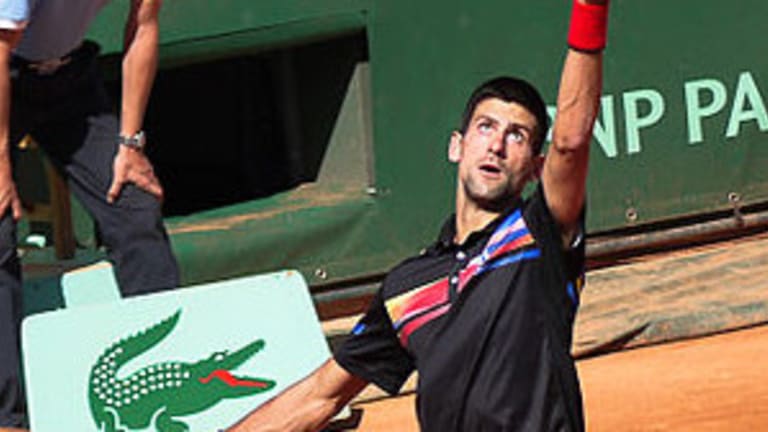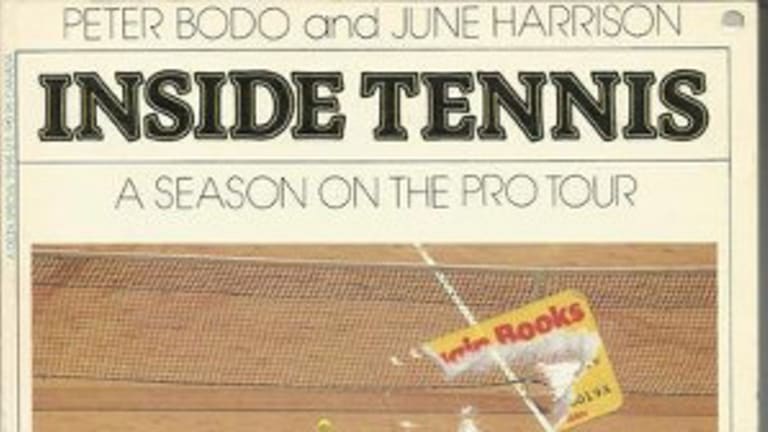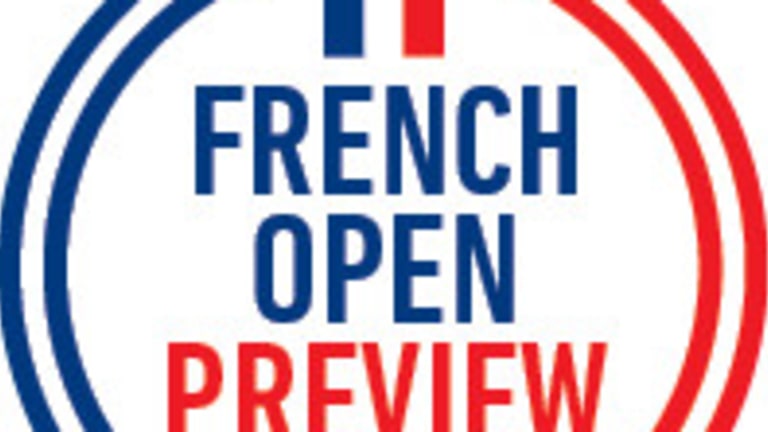This week I’m Rallying with my colleague here at TENNIS, Pete Bodo. In advance of his upcoming trip to Paris, we talk about the French Open past and present.
Quatre: The Roland Garros Rally
By Steve Tignor May 22, 2014Federer Turns 40
The Rally: 20-plus years in the making, how writing The Master humanized Federer for its author
By Steve Tignor Aug 08, 2021Roland Garros
The Rally: Is Novak Djokovic's Roland Garros triumph the most remarkable of his 19 Slam-title runs?
By Joel Drucker and Steve Tignor Jun 13, 2021The Rally: Sliding into the clay swing as Roland Garros looms
By Joel Drucker and Steve Tignor May 10, 2021The Rally: How notable is Novak Djokovic's new No. 1 ranking record?
Mar 09, 2021The Rally: A Wild Idea
By Steve Tignor Sep 03, 2015Role Model
By Steve Tignor Dec 19, 2014The Rally: Off-Season? What Off-Season?
By Steve Tignor Dec 18, 2014The Rally: Back on the Bus
By Steve Tignor Jul 23, 2014The Rally: Transition Time
By Steve Tignor Jun 11, 2014Quatre: The Roland Garros Rally
Like its surface, change at Roland Garros has been slow, but sign
Published May 22, 2014
Advertising
This weekend you're heading back to Paris for the French Open again. I know you've been covering the event since the 1970s, so you've seen it change quite a bit. The first time I was there was in 1998, and in the 15 years since, I haven't noticed any great transformation at Roland Garros. There are still the big three arenas, and there are still the tiny, jammed side courts "out in the country."
For fans my age and younger, the French Open has always seemed solidly third, or perhaps second, in line in prestige among the majors, behind Wimbledon and (possibly) the U.S. Open. For us, it's the Australian Open that has upped its game in the last 20 years. Yet in the 70s it was a different story for Roland Garros. its most famous champions—Bjorn Borg and Chris Evert—were willing to skip it to play World Team Tennis, which is unthinkable today. How do you remember those days in Paris, and how do you remember the man who turned it around there, Philippe Chatrier?
Well, that analysis is spot-on. The thing to remember about the French Open is that in many ways it is ultra-conservative or, if you prefer, traditional—perhaps not in the more creative enterprises (there's a reason "avant-garde" is in our vocabulary), but in many other areas of French culture, and its attitude toward some institutions. Thus some of those entities were slow to evolve. That's the case with Roland Garros, which was the last of the four Grand Slam tournaments to accept international players. It was really the "French Closed" for a long portion of its early existence, functioning as national championship in which only natives were allowed to compete. Once the French Open began accepting international players in 1925, it quickly took its place as the world championships of clay.
Advertising

Quatre: The Roland Garros Rally
But the French still retained its distinct flavor, in ways both positive and negative. As the game grew in the new, Open era that began in 1968, the tournament flourished, but it did not grow. The facilities, most of which have since been renovated or replaced, were a charming, ivy-covered, mullion-windowed mess. Players from elsewhere—especially Anglo players—saw the tournament as a kind of novelty. It was a charming interlude and interesting test before the real tennis began on grass. But before I get into the changes and people who transformed the tournament, I'd like your opinion on something: Is there a place in the world for "closed" tournaments? I mean, isn't Barcelona something like the "Spanish Closed" in all but name? Would it grow the game if tennis were, at least some of the time, less rather than more international?
Advertising
Closed events—an interesting idea that I don't think I had ever considered. Pro tournaments that would function as national championships, is that the idea? I do think that would work in the U.S., where we no longer see our men, or most of our women, challenge for big international titles. I think if it was built up and hyped properly, it would have prestige with players and fans here. Soon enough, we might even be calling it the "World Series of Tennis."
Thinking about the Anglo-French split in tennis' past that you mentioned, it's interesting how much the Anglo side has faded and the Continental side has grown. A few years ago, I read a history of tennis from the 1960s by British journalist Rex Bellamy in which he talked about what a novelty it was to try to pronounce the names of the Eastern Europeans who would show up out of nowhere at the French Open. The grass game, as you said, was still dominant then, and the best players were Americans and Aussies. Now there are very few of either at the top of the rankings, and the Eastern Europeans are everywhere. Even the modern playing style has shifted to the baseline game that we used to see primarily on clay. So in a sense the sport has moved toward Paris over the decades.
You make a good point about the way the game "has moved toward Paris," and if we want to measure just how much the game has changed, let's get back to Rex Bellamy, that icon among tennis writers. (Maybe we can have a critical discussion about Rex's work during Wimbledon!) I knew Rex; he was a pleasant, kind, very mellow man. He was somewhat famous in our incestuous little set for writing, of tennis at the French Open and on clay in general (and if this isn't the exact quote, it's close enough): "It's rather like watching a dachshund sit up and beg. It's amusing the first few times but then it becomes tedious."
The condescension in the observation screams out, but keep in mind that Bellamy was working at a time when, in all honesty, clay-court tennis often was a tedious exercise, consisting mostly of two guys engaging in seemingly interminable rallies featuring very little in the way of imagination, creativity, or risk-taking. I love Jose Higueras, but in my book he was one of the worst offenders, and some of the players who immediately preceded him were even less inspiring to watch.
Advertising

Quatre: The Roland Garros Rally
You also mentioned the Eastern Europeans, and being one myself I have to admit to some prejudice in their favor. But also, the people from that region have always suffered because many of them have been dominated from the East (Russia) while wanting nothing more than to be accepted by the West (from which they took many of their cultural and intellectual cues). Yet the West has never really embraced Eastern Europe. Remarkably, there still seems to be vestiges of that in tennis. You can see it in the way Novak Djokovic is perceived. Am I being paranoid, or do the crowds, especially in Paris, seem a little stand-offish toward Nole, as if they don't quite know what to make of him?
Advertising
I've also wondered about Djokovic's acceptance by tennis crowds around the world, and if there isn't something about him being Eastern European that keeps fans from embracing him the way they've embraced, say, Switzerland's Roger Federer. In the days of the Iron Curtain, Ivan Lendl and Martina Navratilova, despite becoming enthusiastic American citizens, were cast mostly as villains. Djokovic has had the misfortune to come along in the wake of two popular male players—Federer and Rafael Nadal—and he was viewed early on as "brash" for daring to challenge them. Novak has obviously worked hard to be liked since then, but it may be a little tougher for Brits, Americans, Aussies, and Western Europeans to get behind him.
Having watched Djokovic play Nadal in all four Grand Slam finals, I thought he was best-liked in Paris, but that could just be because the style-loving French have never taken to the grunting and grinding—and Spanish—Nadal. I'm guessing that the French will have an easier time rooting for another Eastern European, Grigor Dimitrov, in part because he plays like their all-time favorite, Federer, but also because he seems more Westernized. In this sense, if his profile continues to rise, the Bulgarian could be a breakthrough character in tennis.
Speaking of the Parisians, are you looking forward to watching tennis with them again next week? They can be harsh and intrusive, as we know, but when I think of some of my best tennis-viewing memories, a lot of them have come at raucous matches at Roland Garros.
To be honest, while I often enjoy French Open matches I get a little annoyed with the degree to which the French are into style, sometimes at the expense of substance—that also is a factor in the relative indifference they've shown toward Nadal. The ultimate player for the French probably still is Ilie Nastase, who had the most "artistic" game, and the most conspicuous degree of personality (not all of it appealing) that this game has seen. Now as much as I love Ilie, who's a kind of Romanian Tom Sawyer (you can see him in rock star mode at Roland Garros at the 2:30 mark in the video below), he had numerous shortcomings and simply could not be trusted to win a tennis match. The French embraced him because of the "rock star" factor, not the tennis factor, and I thought that was silly.
Advertising
I also can't stand a few of the French fans' familiar habits—especially that weird, drawn-out, guttural exclamation the kids so frequently holler out: Ah-waaaaaayyyyy. I'm embarrassed to admit it took me over a year to figure out that it's just a distorted way of shouting out the common encouragement, "Allez!" ("Go!")
I put some of this down to the fact that for all the talk about Paris, Roland Garros is like the other Grand Slams. A tremendous number of the fans (almost anyone outside the corporate seats), while not exactly pumpkin rollers, aren't your cutting-edge Parisians, either. What they are, to me, is a somewhat fickle lot experiencing a national tradition.
You know my favorite memory of watching tennis in Paris? A few years ago I found myself sitting behind and watching a father and his nine- or 10-year-old son on a sparsely populated outside court (I imagined they just had ground passes, but who knows?) while a junior match was in progress. They had brought their own lunch and shared it while they watched: Naturally, it was cheese and some sort of cold cuts and baguette—a very French bag meal. They were so obviously having a good time, and bonding as father and son, that I found it sweet beyond words and I couldn't help but watch and enjoy the sight of it. That it was a match between two unknown juniors and not a Federer vs. Nadal battle in the house that Philippe built mattered not at all.
Advertising
Your story of father and son enjoying a junior match reminds me again that, whatever we think of the crowds at Roland Garros, the French know and like tennis. While the sport chases after emerging markets in Asia, it's often forgotten how mature, and important, the tennis market remains in France. It may not produce Grand Slam champions, but the country produces entertaining players and holds pro tournaments where spectators actually fill the seats. Paris has a Grand Slam, a Masters event, and a women's tournament; Babolat is the world's biggest racquet company; and BNP Paribas seems to sponsor half the tour. And it's hard to think of a place where the sport feels more dramatic than inside Chatrier.
That brings me back to my earlier question for you about the long-running renaissance at Roland Garros. What are your memories of it in the 70s, and what are your memories of the man who transformed the event, and whose name is on its biggest court, Philippe Chatrier?
Boy, I could certainly go on about that subject! I think the French Open in the 70s was a blast, and the mistake Chrissie, Bjorn, and Jimmy Connots made in skipping the tournament in favor of World Team Tennis was critical. I guess the tournament was cool in a very 1970s kind of way—remember the famous picture of Borg climbing out of a window surrounded by ivy, with the girls in hot pursuit? It was like that all over, and therefore exciting to be a part of that scene. The tournament was rough around the edges; it was incredibly crowded (the facilities were poor, to say the least), often hot, difficult to navigate (vis a vis things like the daily schedule and court assignments)...but unfailingly electric.
Advertising

Quatre: The Roland Garros Rally
It reminds me now that while I was working on my first tennis book (Inside Tennis: A Season on the Pro Tour), I lost a thick notebook full of stuff I would need for my manuscript from the Italian Open and a few earlier events. In a panic, I took a cab back to Roland Garros from some night spot at around 2 A.M. and actually climbed the wall protecting the grounds, and basically broke into the "press center" (such as it was) in my eagerness to recover the lost item. I didn't find it, but I got a stern talking to the next day from the lady in charge of the press—who also had my notebook in her possession, as someone else had found and turned it in.
Can you imagine trying to sneak over a fence these days at a Grand Slam event in the dead of night? You'd get shot.
However, the tournament organizers also recognized that the event had outgrown its shoes, so to speak, and had to be significantly upgraded. This the French were somewhat reluctant to do (the aforementioned conservatism being a main factor) until Chatrier, a reformed journalist, took over at the Fédération Française de Tennis (FFT). He saw that the tournament could become the European Grand Slam and even transcend that status to become, like Wimbledon, a global brand.
Philippe wasn't afraid to compete with Wimbledon and the U.S. Open, and the result was the long-term renovation that ultimately gave us Lenglen, the Bullring, an increase in show courts, better seating at some outside minor courts, etc.—and a dramatic rise in the prestige of the French Open. Remind me to tell you a funny anecdote about how hard Phililppe worked to achieve his ends, but first tell me what your impressions of the tournament were when you were growing up in a relatively sleepy Pennsylvania town—and what, if anything, changed those impressions as you embarked on your career?
Advertising
Your tales of the 70s at Roland Garros remind me of the documentary The French, by William Klein. It covers the 1981 tournament, which turned out to be Borg's last and now seems like the end of that freewheeling era. Nastase, Chrissie, Jimmy, Bjorn, John McEnroe, a young Yannick Noah and Hana Mandlikova, Chatrier himself—they're all there in their enfant terrible glory. (See an epic Mac meltdown below.) It looked like a smaller world then. At the very end, the camera flies through the tiny press room, where you can glimpse Frank DeFord banging away furiously on a typewriter. How did you get your words back to the States in those days?
Advertising
The French Open was something of a glamorous mystery event in the States when I started following tennis in the late 70s and early 80s. My first knowledge of it came through Curry Kirkpatrick's articles in Sports Illustrated. But soon after that, USA Network began showing virtually the whole thing; I guess they needed to fill a lot of air time. So I got used to those trademark slow-motion, close-up replays that you see on French TV.
It looked like an alternate tennis universe, and that's exactly how it felt when I first went to Roland Garros in 1998. The World Cup was being played in Paris that year, and the Brazilian soccer star Ronaldo showed up in Chatrier—with Anna Kournikova, naturally—on the day I was there. The crowd stood to applaud, while the Americans I was with asked each other, "Who's that?" and shrugged. But I thought it was a cool way to add to the foreign flavor of the whole event—even the celebrity athletes there were unknown to me.
What I liked most, though, and what I still love about the French, is seeing clay-court tennis, with all of its physicality, up close. But you're right—the endless "Allllleeeezzzzzz!!!!!"s from kids in the audience should be outlawed.
I forgot that Chatrier was a former lowly journo. How did he treat his ex-colleagues?
Wow, I'd almost forgotten—all day clay-court tennis from the often damp and gray precincts of Roland Garros. You were as much of a trooper then as you are now! But then, I guess we tennis watchers are as bad as the pros themselves when it comes to the wash, rinse, spin, repeat nature of this game. Just imagine how many forehands Rafa has hit in his life—or how many we've watched him hit.
Back in the day, the filing options were dictation over the telephone (most common), Western Union telegram, and finally the precursor to today's digital tools, the mimeograph machine-like instrument. You loaded your typed page onto this cylindrical tube (almost the same exact size as your typical kitchen rolling pin), closed the lid, put a telephone into the built-in cradle, and hit a button—whang!—the tube began to spin madly and in as little as 10 minutes an entire page of copy was transmitted. Man, I feel old sometimes and I'm amazed at how we got it all done with those primitive tools.
Philippe was a terrific guy who never put on airs even when he went on (later in his life) to become a big-wig in the International Olympic Committee. He understood journalists and their needs as well as their desires.
Now imagine the sound of me clearing my throat as I relate this anecdote. Early in his drive to bring the French Open up to speed, he recognized that he needed to win over the foreign press—particularly the Anglo press, which was inordinately if understandably fixated on Wimbledon and the U.S. Open. He was always after me to cover the French Open, but back then many editors (including my own) weren't convinced that the expense of sending a reporter over to Europe for two weeks was worth it. When I explained that to Philippe one time, he invited me over as a "guest" of the FFT.
That was a nice offer, but obviously raised some red flags as far as journalistic ethics go. In all fairness, though, I was working for TENNIS magazine, not a news-gathering agency. Therefore, accepting that kind of financial support wasn't necessarily the same thing. In any event, my editor told me that if they were going to be so welcoming, I ought to take them up on it, and I booked my flight and hotel. All went well, and after a few days at Roland Garros I saw Philippe. He asked how my flight and hotel were, and I replied all was good. Then he handed me an envelope stuffed full of French francs (this was pre-Euro) to cover my expenses.
I'm not going to be a cynic or an ingrate, but I had expected to have to turn in receipts to the FFT. Instead, I found myself holding an uncomfortably large amount of cash with which I obviously was free to do whatever I wanted. The amount wasn't inordinately more than my expenses, and I dutifully used all of it to cover all the items on my expense report.
But like I said, Philippe knew how (some) journalists work and in the end I suppose you can say he did me the honor of trusting my integrity. And above and beyond that, he certainly knew how to reach out and get his event covered.
Advertising

Quatre: The Roland Garros Rally

Quatre: The Roland Garros Rally
Advertising
Un:Is there a "French" Andy Murray?
Deux:Gaudio vs. Coria, 10 Years Later
Trois:Paris Podcast
Quatre:The Roland Garros Rally
Cinq:Michael Chang's Win, 25 Years Later
Plus:
Men's Preview: Round Three at Rolly G?
Women's Preview: Rising to the Top
And be sure to visit our French Open page for more coverage.